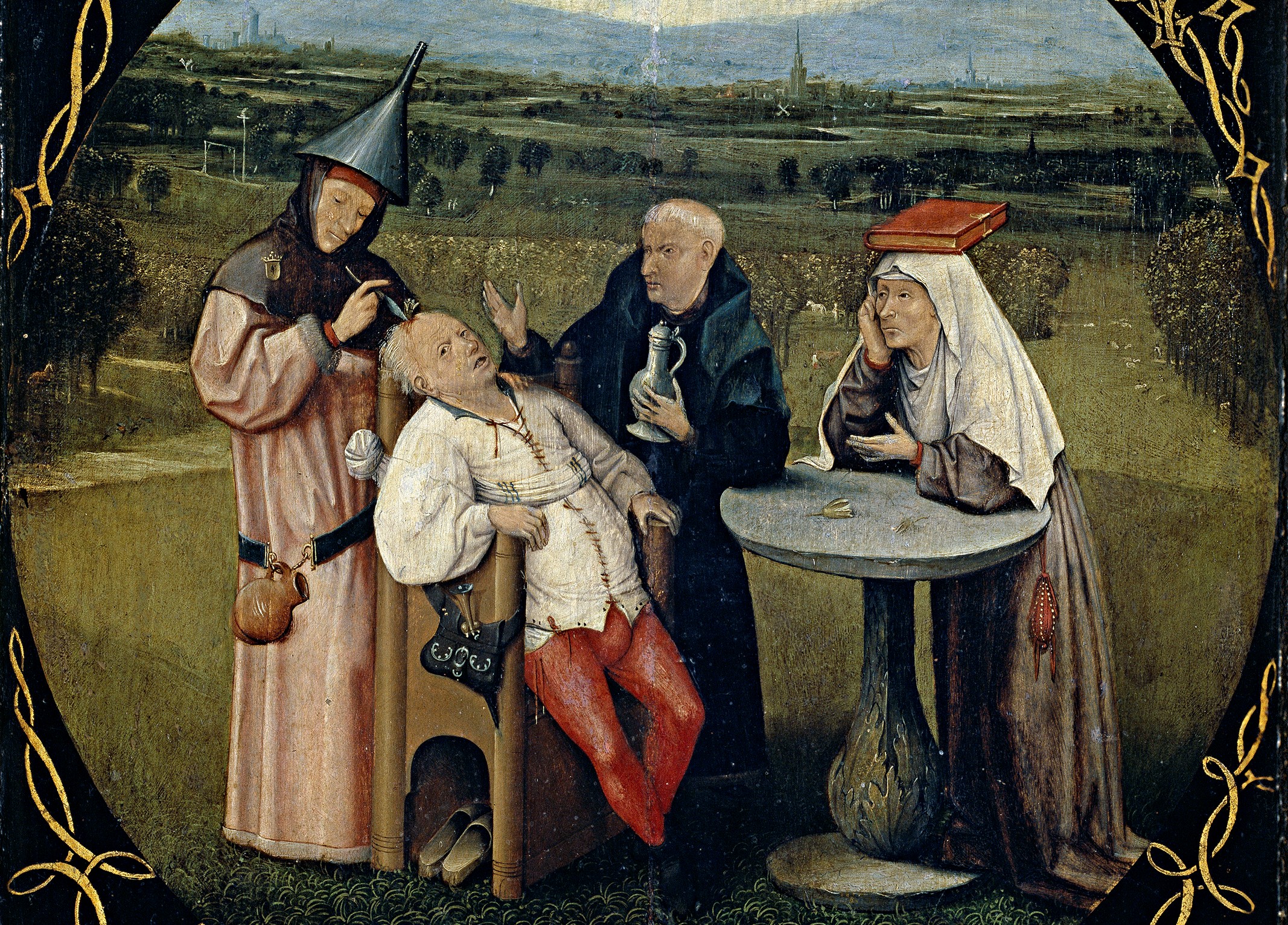 bout five centuries ago, the philosopher, humanist, and theologian Erasmus of Rotterdam wrote “The Praise of Madness,” a terrible satire book representing the society in which he lived. Unfortunately, this book remains relevant because not much has changed since the time of Erasmus, or nothing has changed for the better. For example, society’s perspective on the “crazy” and the “healthy” is that mental normalcy is still perceived by the majority as not suffering from any mental illness.
bout five centuries ago, the philosopher, humanist, and theologian Erasmus of Rotterdam wrote “The Praise of Madness,” a terrible satire book representing the society in which he lived. Unfortunately, this book remains relevant because not much has changed since the time of Erasmus, or nothing has changed for the better. For example, society’s perspective on the “crazy” and the “healthy” is that mental normalcy is still perceived by the majority as not suffering from any mental illness.
Was madness given by the gods or provoked by evil spirits?
The skulls of the Australopithecus, Neanderthals and even Homo sapiens of the Stone Age and early civilizations often bear traces of trepanations (points of the skull being perforated intentionally). It is believed that the ancient shamans opened the “gates” through which evil spirits were forced out of the “patient’s” mind by “specific procedures.”

Ethnologists and anthropologists have also found that amulets were made from the pieces of bone cut from the skulls of those treated in this way. It seems that the people of the stone ages were better at studying anatomy than we could have thought, and they had already learned that the organ of thought was the brain.
While physical illness passed quickly under the “jurisdiction” of secular medicine, mental illness continued to be a monopoly of healers and priests for a long time. From Ancient Egypt, not only a few dental works of exceptional quality have been preserved, which defied the millennia, but also the following incantation, recited to drive away the evil spirits from children with mental disorders:
“You go, the one who comes from darkness / You the one with the steered nose back / And the face twisted from the back / You, who do not know what good you came to / Did you come to kiss my child? / I won’t kiss. / Did you come to put him to sleep? / I’ll stop you from hurting him. / Did you come to take him with you? / I won’t give it to you, but I won’t break it either./ I gave him a powerful talisman against you! ” (Incantation used by Priests against those who had mental ilnesses)
In the Indian subconscious, lunatics were left “in their pain,” believing that this was how they paid their karmic debts — the sins accumulated in previous reincarnations. In ancient Greece, epilepsy was considered a divine punishment. Instead, delirium was considered a “gift of the gods”, which is why it was, in some cases, it was artificially induced by the administration of hallucinogenic substances, orally or by inhalation.
The example of Pythia, the priestess of Apollo at Delphi, is well known. The ancient Jews also considered insanity a divine punishment. The Bible describes the episode in which the Babylonian king Nebuchadnezzar is punished by Jehovah and falls prey to dementia, eating hay, which he took as meat. Vegetarians were apparently not taken too seriously in those days…
Apollo’s descendants were famous doctors but also psychiatrists. Let us return, however, to the Greek world, where Apollo, the “imported” god from the north, was not only the son of Zeus, the god of the Sun and Light but also a healer.
This prerogative (passed on to St. George, his Christian substitute) is inherited by his son, Asclepius (Aesculapius). This son of Apollo had a temple on the island of Kos, which enjoys an excellent reputation among the medical schools of antiquity. There he learned, in the time of Pericles, the young Hippocrates, the offspring of a noble family who proudly asserted their descendants from Asclepius (and therefore from Apollo).
After “graduating from medical school”, Hippocrates becomes a periodical, ie itinerant doctor. He has traveled through Greece, Libya (Africa) and Scythia (today’s Dobrogea and Ukraine), gaining extensive and valuable clinical knowledge. He left behind a vast (incompletely preserved) medical work in which he also deals with mental illnesses, which had nothing divine, in his opinion:
“Blaming the gods for a disease means hiding our inability to cure it.” , he wrote.
Hippocrates also states that the organ of thought is the brain and finds that certain diseases, such as dysentery, dropsy or even the common cold can cure certain forms of dementia.
Three hundred years later, doctors Herophilus and Erostratus of Alexandria were to discover the role of nerve pathways in transmitting influxes from the brain, as well as the connection between convolutions and the thought process.
This line of thinking was continued in Roman times by Galen. Born in the city of Pergamum in Asia Minor, a famous cultural center of antiquity, Galenus would write over five hundred medical treatises, of which, unfortunately, nothing has been preserved. He introduced animal experiments into the history of medicine: by opening the skull of a live pig, he found that the pressure exerted on the brain leads to a loss of sensitivity and motor functions. His conclusion was that any mental illness is caused by direct or indirect damage to the brain.
How the western world dealt with the mentally ill
In Europe, however, things were completely different. If in the Byzantine Empire — the lunatics were detected by officials called ducteres and interned in xenodocs (hospitals that were both shelters for the poor), where they were treated humanely. In Germany, for example, they were the so-called “towers of the lunatics “.

The Scots were more expeditious: they threw them into the “frenzy wells”, the wells of delirium. The English killed them with Malleus Maleficarum, the hammer with which they killed witches. The French put them in chains. At other times, the madmen were imprisoned in lepers, or when there were too many, they were loaded on the famous “ships of the madmen,” like the one painted by Hieronymus Bosch, and left to their own devices.
Even during the Renaissance era treatment for the mentally unhealthy saw little progress. Beginning in the seventeenth century, medicine began to develop. Some isolated voices, such as that of the English physician Sydenham, who wrote that fools are just poor sick people and not “possessed by the devil” were not taken into account by “normal people”.
The lunatics were interned in asylums, where the regime was worse than in prisons: the insane were left to starve, chained, beaten with a whip, and burned with red iron on the scalp. The largest hospice in Europe was Salpetriere in Paris, where 7–8,000 “patients” were forced to work 14 hours a day and pray for six more.

The hospice in Brunswick, Germany, placed great emphasis on the “labor productivity” of the insane. For this purpose, they were exposed to fairs, to be seen for a fee by “normal people”. The “treatments” to which the insane were subjected were absurd and barbaric. Under the pretext that immobility, oscillations or centrifugal movement improve their condition, they were subjected to real tortures, inspired as if by the Inquisition, in specially built devices.
Improving the life of the mentally ill

The “liberation” of the insane began in 1793, four years after the French Revolution. At the Bicetre hospital in Paris, Dr. Philippe Pinel ordered the removal of the chains with which the mentally ill were immobilized. But many of them had lost all trace of physical strength and could no longer move.
The gesture made 228 years ago by Dr. Pinel has more symbolic value. Many so-called “crazy people” continue to lie in hospices only because their relatives wanted to get rid of them to deprive them of their wealth or, even more, because they opposed totalitarian regimes or protested against them.
It is thanks to Dr. Pinel’s work that our society started to treat mental illnesses more seriously as if it was a real illness and not some sort of “blessing” from the gods or a curse from the devil. As society became more technologically advanced, they started to use science to define these mental illnesses rather than religion.
Avid Writer with invaluable knowledge of Humanity!
Upcoming historian with over 30 million views online.
“You make your own life.”





